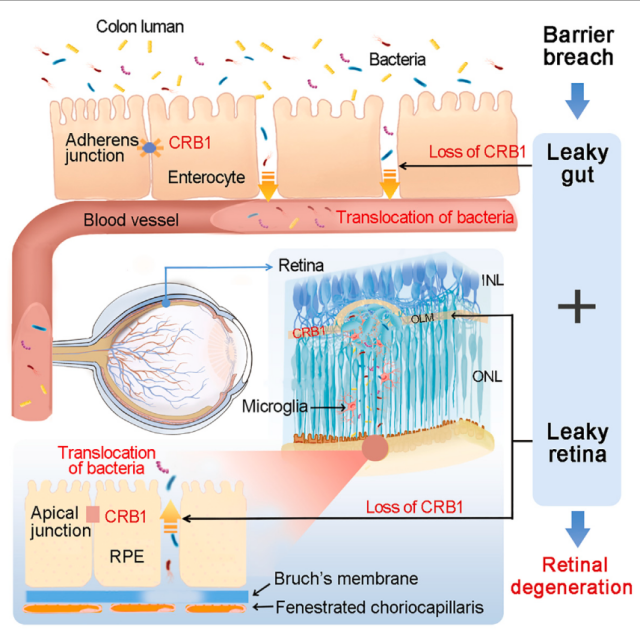Genetic retinal degenerations are mainly caused by genetic mutations, often leading to irreversible blindness with limited treatment options. They are more common in childhood and adolescence, affecting about 1 in 2,000 people. In terms of causative factors, mutations in over 250 associated genes have been found to lead to diseases such as Leber congenital amaurosis and retinitis pigmentosa, among which CRB1 gene mutations are the most common.
After nearly a decade of rigorous research, a collaborative effort led by scientists from the Zhongshan Ophthalmic Center of Sun Yat-sen University (ZOC) and other institutions has achieved a breakthrough. The research results have already been published in the journal of Cell.

(Photo provided to GDToday)
"If our guts are healthy, our immune systems are healthy, and if our immune systems are healthy, our bodies are healthy. What's novel about our report is that bacteria directly leave the guts, move through the bloodstream, and go to the back of the eye," said Richard Lee, the new clinical director of the National Eye Institute on the Bethesda campus of the National Institutes of Health (NIH) in Maryland.
In China, about 100,000 patients have hereditary retinal degenerative diseases, and the figure stands at 1 million globally. Currently, there is almost no cure. However, the new research shows promise for dealing with genetic retinal degenerations.
In previous studies, the research team found that the conventional notion that "the internal compartment of the eye maintains a sterile environment" was not accurate. Researchers found seven types of bacteria in the eyes of patients, and there was a clear correlation between these bacteria and eye diseases.

(Photo provided to GDToday)
How do bacteria enter the intraocular environment? The team made an unexpected discovery in their experiments: there is a link between the gut and the eye, which contains a variety of bacteria, and CRB1 plays an important role in this.
When there is a specific mutation in the CRB1 gene, the barrier between the retina and the gut may be broken, allowing bacteria in the gut to enter the eye, eventually causing retinal damage and leading to blindness.
Remarkably, the researchers successfully prevented the onset and progression of ocular diseases by employing two innovative approaches: broad-spectrum antibiotic therapy and reintroduction of functional Crb1 expression in the lower digestive tract.

Group photo of the research team. (Photo provided to GDToday)
However, this conclusion does not mean that both treatments are suitable for clinical use. Prof. Wei Lai, director of the research team and a visiting professor at ZOC, suggested that the intestinal flora plays an important role in maintaining human body functions, and long-term antibiotic treatment may lead to side effects such as dysbiosis, metabolic disorders, nutritional disorders, and immune disorders, which are not conducive to human health.
In his opinion, gene therapy or local intestinal gene therapy is more feasible, practical, and has more controllable side effects. "However, there is still a long way to go to explore the application of gene therapy in clinical practice, and further research is needed to improve safety, legal supervision, and so on," Prof. Wei said.
Reporter | Hannah
Editor | Steven, Abby, James
















